engine RENAULT SCENIC 2012 J95 / 3.G Engine And Peripherals EDC16CP33 User Guide
[x] Cancel search | Manufacturer: RENAULT, Model Year: 2012, Model line: SCENIC, Model: RENAULT SCENIC 2012 J95 / 3.GPages: 510, PDF Size: 2.98 MB
Page 19 of 510

13B-19V12 MR-372-J84-13B300$030.mif
DIESEL INJECTION
Fault finding – System operation13B
EDC16CP33
Program No.: C4
Vdiag No.: 04, 08, 18, 1C,
20, 24, 26, 28, 34, 38, 44,
4C, 54, 58, 5C, 60, 62, 74
Warning light management:
Instrument panel display
The computer displays certain information on the instrument panel relating to engine operation. This concerns five
functions:
– the pre-postheating warning light,
– the coolant temperature warning light,
–the level 1 fault warning light (non-critical fault),
–the level 2 fault warning light (emergency stop),
–the EOBD (European On Board Diagnostic) warning light,
These six functions are represented by 3 warning lights and/or messages displayed by the on-board computer.
Orange pre-post heating/non-critical fault SERVICE warning light (severity 1)
This light is used both as an in-operation indicator light and as a system fault indicator:
– Continuously lit with + after ignition feed:
Indicates preheating of the spark plugs.
– Continuously lit with the Check injection message:
Indicates a level 1 fault (involving operation of the injection system in defect mode).
The driver should have the repairs carried out as soon as possible.
Temperature / red emergency STOP warning light (level 2)
This indicator light is used both as an in-operation indicator light and as a system fault warning light. It lights up for
3 seconds after the ignition is switched on (automatic test procedure managed by the instrument panel):
– Continuously lit:
Indicates engine overheating (the driver is free to choose whether or not to stop the vehicle).
– Continuously lit with the faulty injection message:
Indicates a level 2 fault (In this case, the injection is automatically cut after a few seconds).
The driver should carry out repairs as soon as possible.
ORANGE Excessive pollution EOBD warning light
Symbolised by an engine, it lights up for approximately 3 seconds when the ignition is switched on.
This warning light comes on if the system has one or more EOBD faults.
This warning light is used to alert the driver to injection faults that could lead to excessive pollution, or if the EOBD
system (European On Board Diagnostic) has been deactivated.
The injection computer requests illumination of the EOBD warning light for a present fault only after three
consecutive driving cycles.
The 3 second visual inspection when the ignition is switched on (automatic test procedure managed by the
instrument panel) is carried out by the injection computer.
Special particle filter ORANGE warning light or warning message (depending on instrument panel)
Only for Vdiag: 18, 1C, 54, 20, 58, 5C, 24, 26 and 60.
This warning light or message is used to warn the driver that the particle filter is loaded with particles, (see the soot
weight thresholds for illumination of the warning light for fault DF312 Speed request) due to driving conditions which
were not suitable for regeneration to take place. The driver must then drive as soon as possible at an average speed
of 48 mph (80 km/h) subject to the road conditions and authorised speed limits, until the warning light goes out.
Page 20 of 510
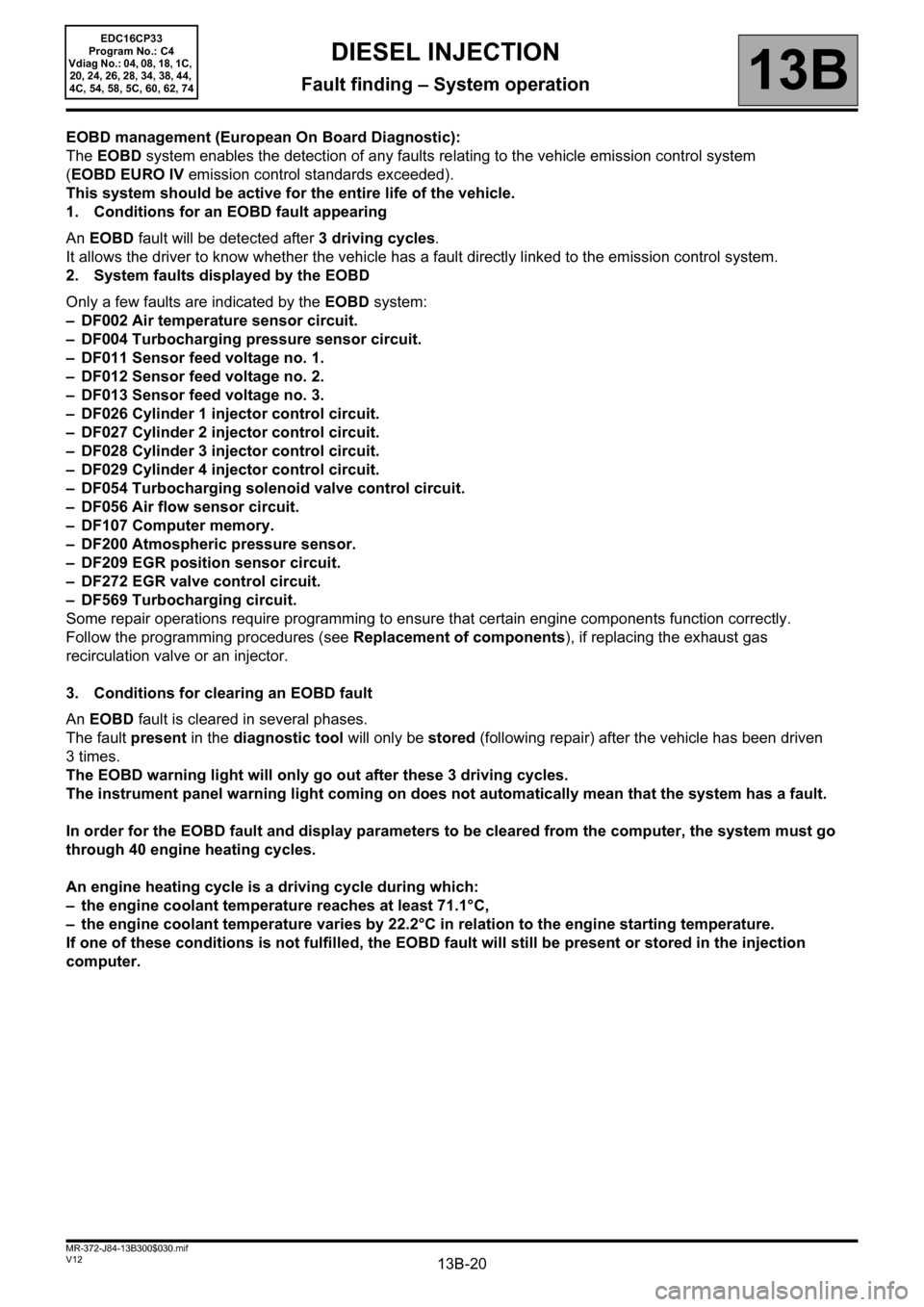
13B-20V12 MR-372-J84-13B300$030.mif
DIESEL INJECTION
Fault finding – System operation13B
EDC16CP33
Program No.: C4
Vdiag No.: 04, 08, 18, 1C,
20, 24, 26, 28, 34, 38, 44,
4C, 54, 58, 5C, 60, 62, 74
EOBD management (European On Board Diagnostic):
The EOBD system enables the detection of any faults relating to the vehicle emission control system
(EOBD EURO IV emission control standards exceeded).
This system should be active for the entire life of the vehicle.
1. Conditions for an EOBD fault appearing
An EOBD fault will be detected after 3 driving cycles.
It allows the driver to know whether the vehicle has a fault directly linked to the emission control system.
2. System faults displayed by the EOBD
Only a few faults are indicated by the EOBD system:
– DF002 Air temperature sensor circuit.
– DF004 Turbocharging pressure sensor circuit.
– DF011 Sensor feed voltage no. 1.
– DF012 Sensor feed voltage no. 2.
– DF013 Sensor feed voltage no. 3.
– DF026 Cylinder 1 injector control circuit.
– DF027 Cylinder 2 injector control circuit.
– DF028 Cylinder 3 injector control circuit.
– DF029 Cylinder 4 injector control circuit.
– DF054 Turbocharging solenoid valve control circuit.
– DF056 Air flow sensor circuit.
– DF107 Computer memory.
– DF200 Atmospheric pressure sensor.
– DF209 EGR position sensor circuit.
– DF272 EGR valve control circuit.
– DF569 Turbocharging circuit.
Some repair operations require programming to ensure that certain engine components function correctly.
Follow the programming procedures (see Replacement of components), if replacing the exhaust gas
recirculation valve or an injector.
3. Conditions for clearing an EOBD fault
An EOBD fault is cleared in several phases.
The fault present in the diagnostic tool will only be stored (following repair) after the vehicle has been driven
3times.
The EOBD warning light will only go out after these 3 driving cycles.
The instrument panel warning light coming on does not automatically mean that the system has a fault.
In order for the EOBD fault and display parameters to be cleared from the computer, the system must go
through 40 engine heating cycles.
An engine heating cycle is a driving cycle during which:
– the engine coolant temperature reaches at least 71.1°C,
– the engine coolant temperature varies by 22.2°C in relation to the engine starting temperature.
If one of these conditions is not fulfilled, the EOBD fault will still be present or stored in the injection
computer.
Page 22 of 510
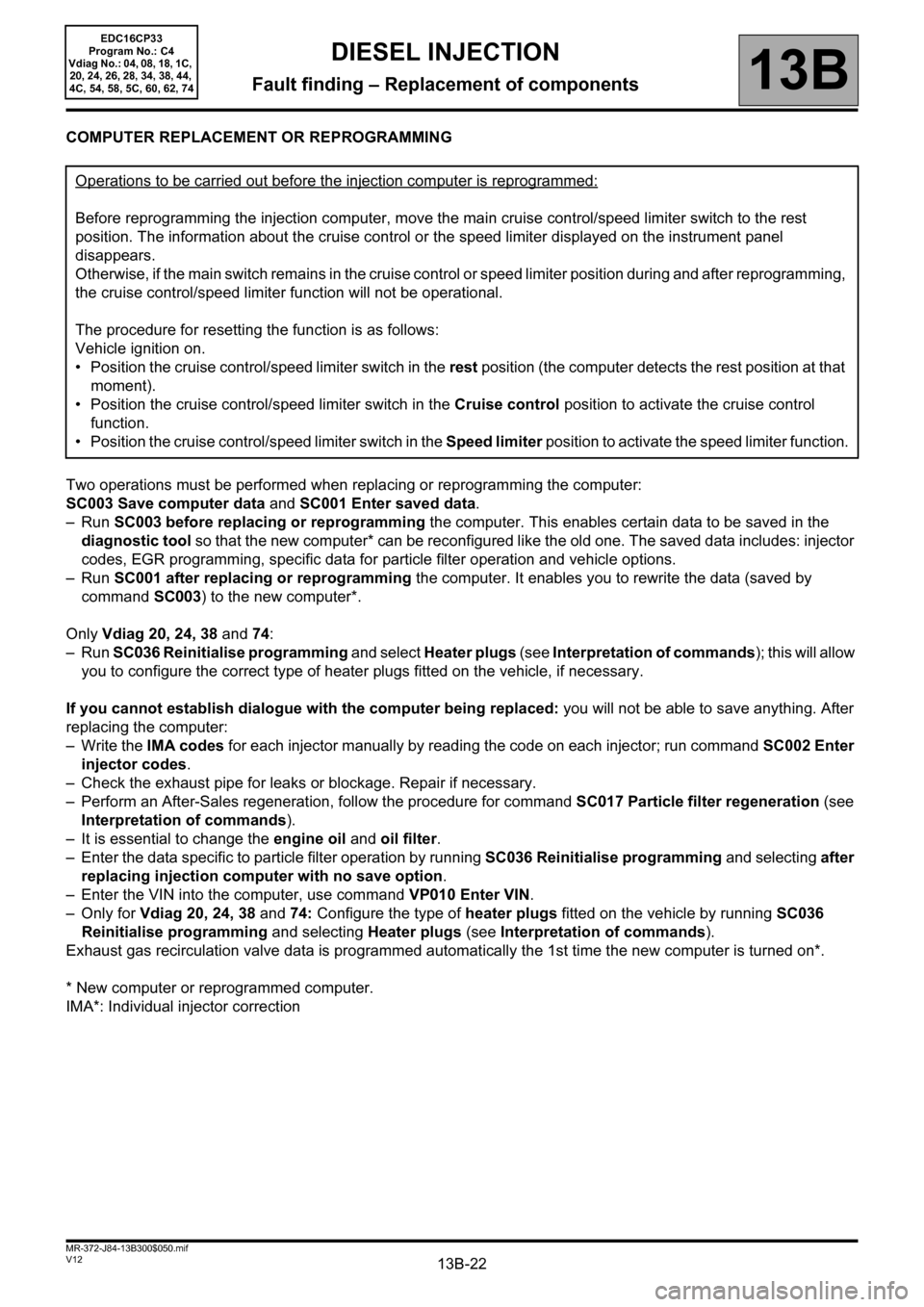
13B-22V12 MR-372-J84-13B300$050.mif
13B
EDC16CP33
Program No.: C4
Vdiag No.: 04, 08, 18, 1C,
20, 24, 26, 28, 34, 38, 44,
4C, 54, 58, 5C, 60, 62, 74
COMPUTER REPLACEMENT OR REPROGRAMMING
Two operations must be performed when replacing or reprogramming the computer:
SC003 Save computer data and SC001 Enter saved data.
–Run SC003 before replacing or reprogramming the computer. This enables certain data to be saved in the
diagnostic tool so that the new computer* can be reconfigured like the old one. The saved data includes: injector
codes, EGR programming, specific data for particle filter operation and vehicle options.
–Run SC001 after replacing or reprogramming the computer. It enables you to rewrite the data (saved by
command SC003) to the new computer*.
Only Vdiag 20, 24, 38 and 74:
–Run SC036 Reinitialise programming and select Heater plugs (see Interpretation of commands); this will allow
you to configure the correct type of heater plugs fitted on the vehicle, if necessary.
If you cannot establish dialogue with the computer being replaced: you will not be able to save anything. After
replacing the computer:
– Write the IMA codes for each injector manually by reading the code on each injector; run command SC002 Enter
injector codes.
– Check the exhaust pipe for leaks or blockage. Repair if necessary.
– Perform an After-Sales regeneration, follow the procedure for command SC017 Particle filter regeneration (see
Interpretation of commands).
– It is essential to change the engine oil and oil filter.
– Enter the data specific to particle filter operation by running SC036 Reinitialise programming and selecting after
replacing injection computer with no save option.
– Enter the VIN into the computer, use command VP010 Enter VIN.
–Only for Vdiag 20, 24, 38 and 74: Configure the type of heater plugs fitted on the vehicle by running SC036
Reinitialise programming and selecting Heater plugs (see Interpretation of commands).
Exhaust gas recirculation valve data is programmed automatically the 1st time the new computer is turned on*.
* New computer or reprogrammed computer.
IMA*: Individual injector correctionOperations to be carried out before the injection computer is reprogrammed:
Before reprogramming the injection computer, move the main cruise control/speed limiter switch to the rest
position. The information about the cruise control or the speed limiter displayed on the instrument panel
disappears.
Otherwise, if the main switch remains in the cruise control or speed limiter position during and after reprogramming,
the cruise control/speed limiter function will not be operational.
The procedure for resetting the function is as follows:
Vehicle ignition on.
• Position the cruise control/speed limiter switch in the rest position (the computer detects the rest position at that
moment).
• Position the cruise control/speed limiter switch in the Cruise control position to activate the cruise control
function.
• Position the cruise control/speed limiter switch in the Speed limiter position to activate the speed limiter function.
DIESEL INJECTION
Fault finding – Replacement of components
Page 25 of 510
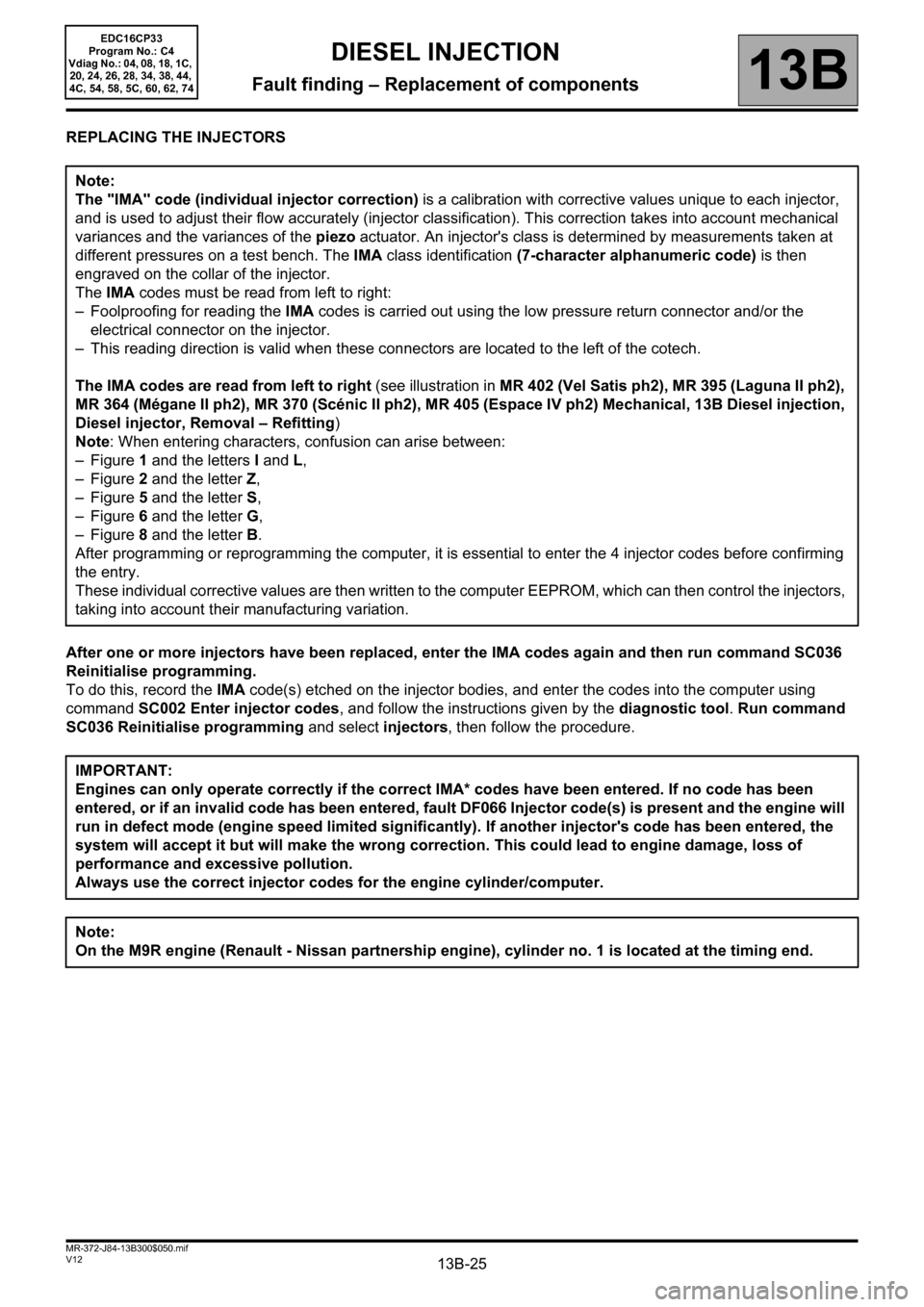
13B-25V12 MR-372-J84-13B300$050.mif
DIESEL INJECTION
Fault finding – Replacement of components13B
EDC16CP33
Program No.: C4
Vdiag No.: 04, 08, 18, 1C,
20, 24, 26, 28, 34, 38, 44,
4C, 54, 58, 5C, 60, 62, 74
REPLACING THE INJECTORS
After one or more injectors have been replaced, enter the IMA codes again and then run command SC036
Reinitialise programming.
To do this, record the IMA code(s) etched on the injector bodies, and enter the codes into the computer using
command SC002 Enter injector codes, and follow the instructions given by the diagnostic tool. Run command
SC036 Reinitialise programming and select injectors, then follow the procedure. Note:
The "IMA" code (individual injector correction) is a calibration with corrective values unique to each injector,
and is used to adjust their flow accurately (injector classification). This correction takes into account mechanical
variances and the variances of the piezo actuator. An injector's class is determined by measurements taken at
different pressures on a test bench. The IMA class identification (7-character alphanumeric code) is then
engraved on the collar of the injector.
The IMA codes must be read from left to right:
– Foolproofing for reading the IMA codes is carried out using the low pressure return connector and/or the
electrical connector on the injector.
– This reading direction is valid when these connectors are located to the left of the cotech.
The IMA codes are read from left to right (see illustration in MR 402 (Vel Satis ph2), MR 395 (Laguna II ph2),
MR 364 (Mégane II ph2), MR 370 (Scénic II ph2), MR 405 (Espace IV ph2) Mechanical, 13B Diesel injection,
Diesel injector, Removal – Refitting)
Note: When entering characters, confusion can arise between:
– Figure 1 and the letters I and L,
– Figure 2 and the letter Z,
– Figure 5 and the letter S,
– Figure 6 and the letter G,
– Figure 8 and the letter B.
After programming or reprogramming the computer, it is essential to enter the 4 injector codes before confirming
the entry.
These individual corrective values are then written to the computer EEPROM, which can then control the injectors,
taking into account their manufacturing variation.
IMPORTANT:
Engines can only operate correctly if the correct IMA* codes have been entered. If no code has been
entered, or if an invalid code has been entered, fault DF066 Injector code(s) is present and the engine will
run in defect mode (engine speed limited significantly). If another injector's code has been entered, the
system will accept it but will make the wrong correction. This could lead to engine damage, loss of
performance and excessive pollution.
Always use the correct injector codes for the engine cylinder/computer.
Note:
On the M9R engine (Renault - Nissan partnership engine), cylinder no. 1 is located at the timing end.
Page 29 of 510
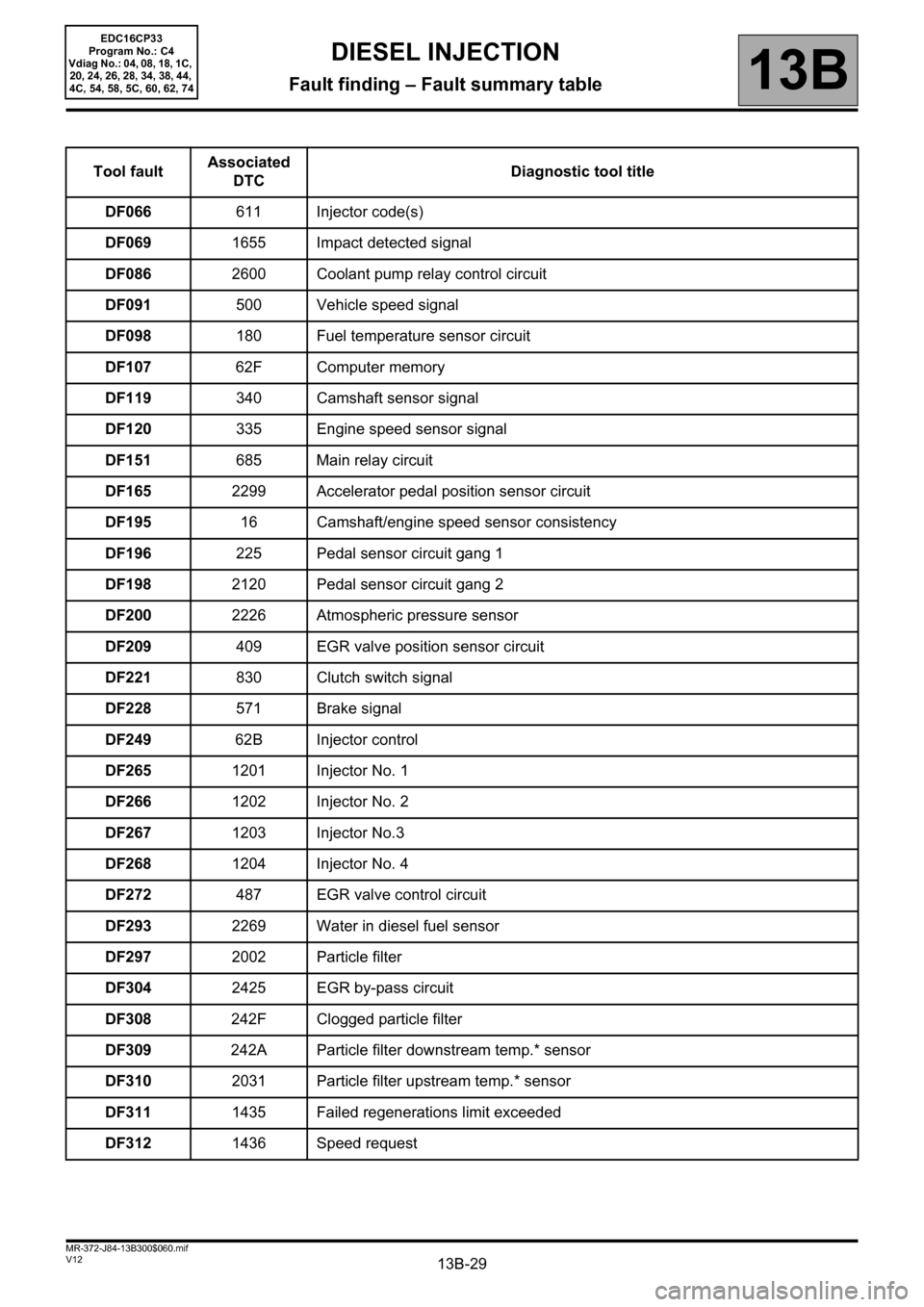
13B-29V12 MR-372-J84-13B300$060.mif
DIESEL INJECTION
Fault finding – Fault summary table13B
EDC16CP33
Program No.: C4
Vdiag No.: 04, 08, 18, 1C,
20, 24, 26, 28, 34, 38, 44,
4C, 54, 58, 5C, 60, 62, 74
Tool faultAssociated
DTCDiagnostic tool title
DF066611 Injector code(s)
DF0691655 Impact detected signal
DF0862600 Coolant pump relay control circuit
DF091500 Vehicle speed signal
DF098180 Fuel temperature sensor circuit
DF10762F Computer memory
DF119340 Camshaft sensor signal
DF120335 Engine speed sensor signal
DF151685 Main relay circuit
DF1652299 Accelerator pedal position sensor circuit
DF19516 Camshaft/engine speed sensor consistency
DF196225 Pedal sensor circuit gang 1
DF1982120 Pedal sensor circuit gang 2
DF2002226 Atmospheric pressure sensor
DF209409 EGR valve position sensor circuit
DF221830 Clutch switch signal
DF228571 Brake signal
DF24962B Injector control
DF2651201 Injector No. 1
DF2661202 Injector No. 2
DF2671203 Injector No.3
DF2681204 Injector No. 4
DF272487 EGR valve control circuit
DF2932269 Water in diesel fuel sensor
DF2972002 Particle filter
DF3042425 EGR by-pass circuit
DF308242F Clogged particle filter
DF309242A Particle filter downstream temp.* sensor
DF3102031 Particle filter upstream temp.* sensor
DF3111435 Failed regenerations limit exceeded
DF3121436 Speed request
Page 30 of 510
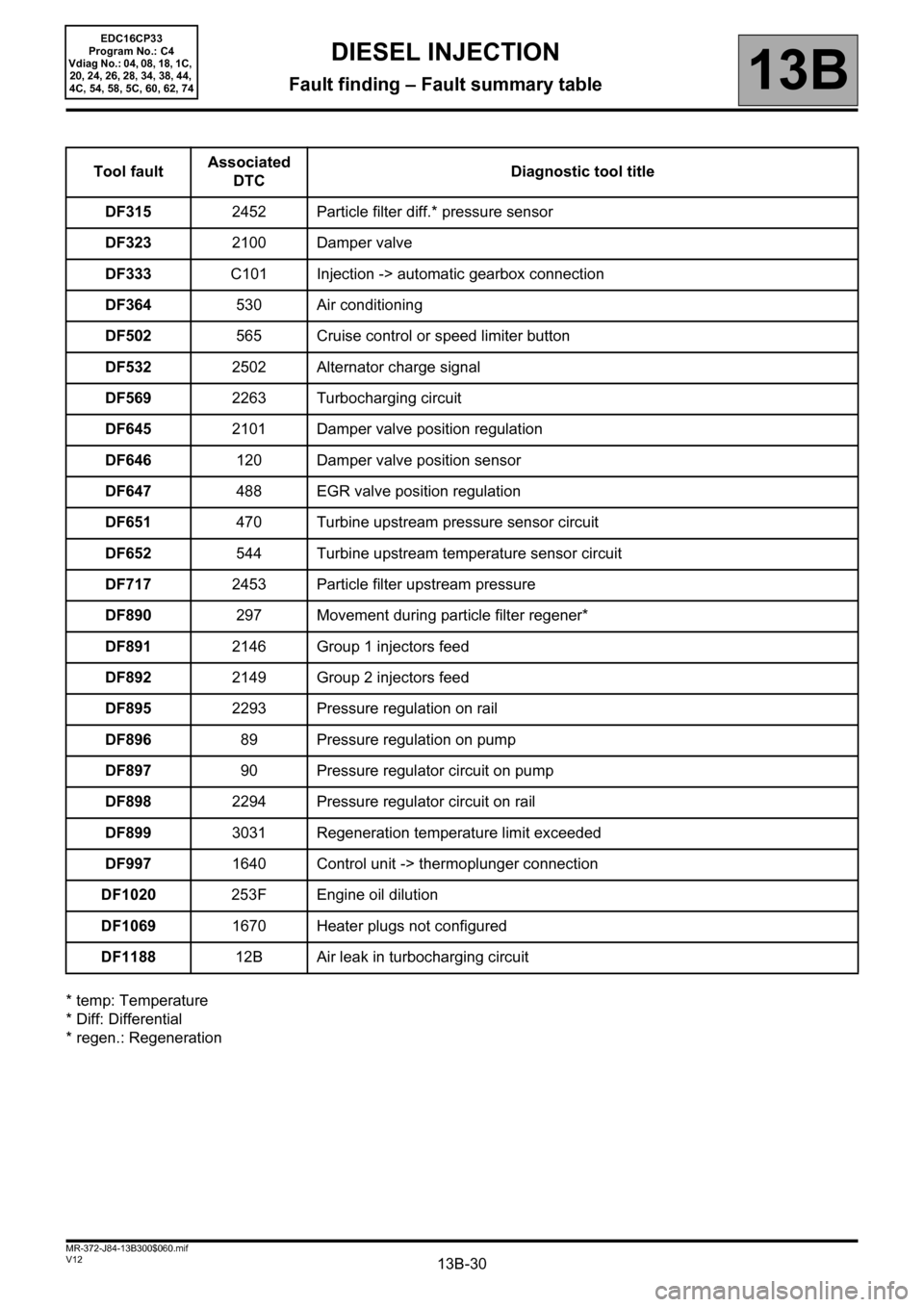
13B-30V12 MR-372-J84-13B300$060.mif
DIESEL INJECTION
Fault finding – Fault summary table13B
EDC16CP33
Program No.: C4
Vdiag No.: 04, 08, 18, 1C,
20, 24, 26, 28, 34, 38, 44,
4C, 54, 58, 5C, 60, 62, 74
* temp: Temperature
* Diff: Differential
* regen.: RegenerationTool faultAssociated
DTCDiagnostic tool title
DF3152452 Particle filter diff.* pressure sensor
DF3232100 Damper valve
DF333C101 Injection -> automatic gearbox connection
DF364530 Air conditioning
DF502565 Cruise control or speed limiter button
DF5322502 Alternator charge signal
DF5692263 Turbocharging circuit
DF6452101 Damper valve position regulation
DF646120 Damper valve position sensor
DF647488 EGR valve position regulation
DF651470 Turbine upstream pressure sensor circuit
DF652544 Turbine upstream temperature sensor circuit
DF7172453 Particle filter upstream pressure
DF890297 Movement during particle filter regener*
DF8912146 Group 1 injectors feed
DF8922149 Group 2 injectors feed
DF8952293 Pressure regulation on rail
DF89689 Pressure regulation on pump
DF89790 Pressure regulator circuit on pump
DF8982294 Pressure regulator circuit on rail
DF8993031 Regeneration temperature limit exceeded
DF9971640 Control unit -> thermoplunger connection
DF1020253F Engine oil dilution
DF10691670 Heater plugs not configured
DF118812B Air leak in turbocharging circuit
Page 31 of 510
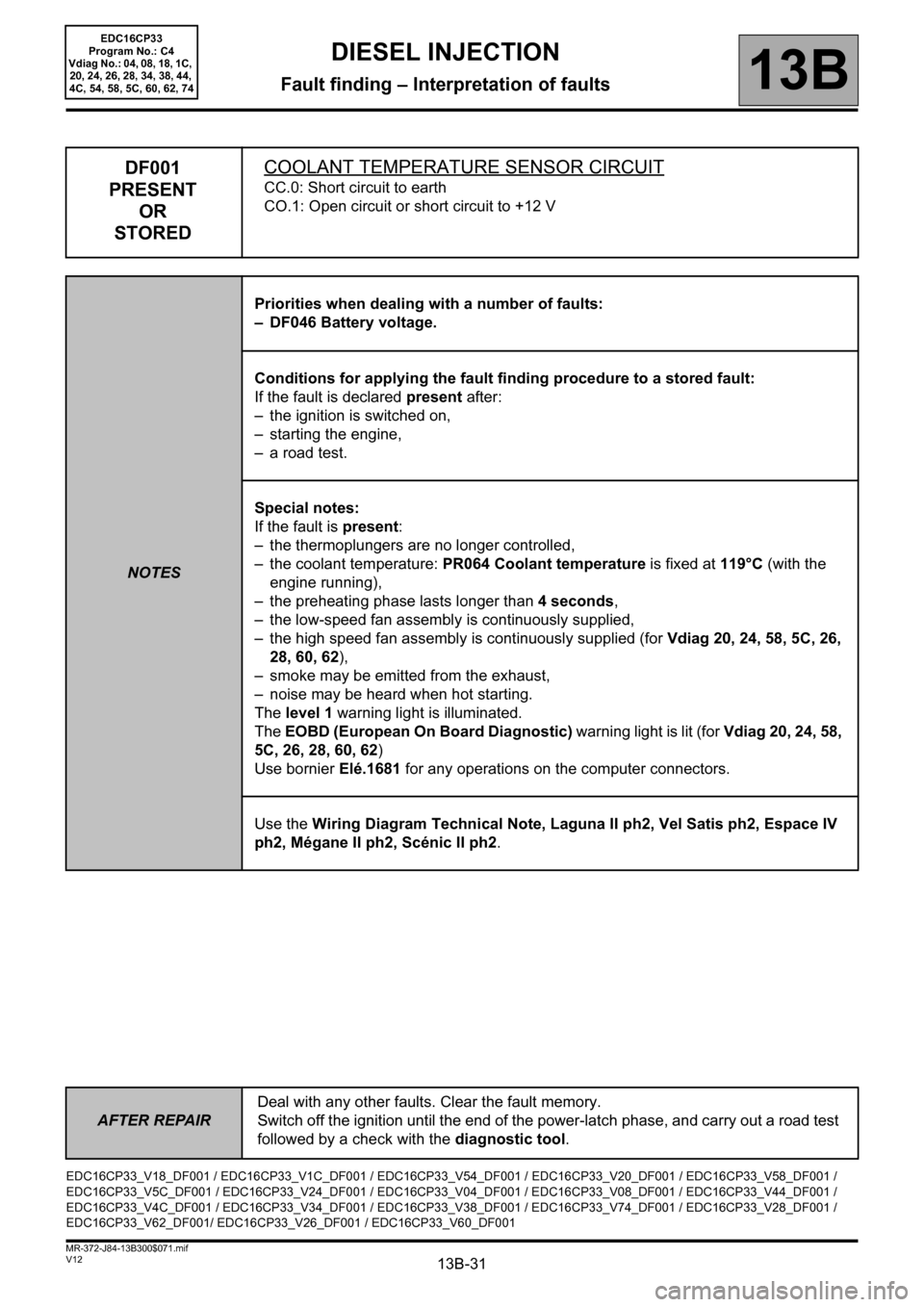
13B-31
AFTER REPAIRDeal with any other faults. Clear the fault memory.
Switch off the ignition until the end of the power-latch phase, and carry out a road test
followed by a check with the diagnostic tool.
V12 MR-372-J84-13B300$071.mif
13B
EDC16CP33
Program No.: C4
Vdiag No.: 04, 08, 18, 1C,
20, 24, 26, 28, 34, 38, 44,
4C, 54, 58, 5C, 60, 62, 74
DF001
PRESENT
OR
STOREDCOOLANT TEMPERATURE SENSOR CIRCUIT
CC.0: Short circuit to earth
CO.1: Open circuit or short circuit to +12 V
NOTESPriorities when dealing with a number of faults:
– DF046 Battery voltage.
Conditions for applying the fault finding procedure to a stored fault:
If the fault is declared present after:
– the ignition is switched on,
– starting the engine,
– a road test.
Special notes:
If the fault is present:
– the thermoplungers are no longer controlled,
– the coolant temperature: PR064 Coolant temperature is fixed at 119°C (with the
engine running),
– the preheating phase lasts longer than 4 seconds,
– the low-speed fan assembly is continuously supplied,
– the high speed fan assembly is continuously supplied (for Vdiag 20, 24, 58, 5C, 26,
28, 60, 62),
– smoke may be emitted from the exhaust,
– noise may be heard when hot starting.
The level 1 warning light is illuminated.
The EOBD (European On Board Diagnostic) warning light is lit (for Vdiag 20, 24, 58,
5C, 26, 28, 60, 62)
Use bornier Elé.1681 for any operations on the computer connectors.
Use the Wiring Diagram Technical Note, Laguna II ph2, Vel Satis ph2, Espace IV
ph2, Mégane II ph2, Scénic II ph2.
EDC16CP33_V18_DF001 / EDC16CP33_V1C_DF001 / EDC16CP33_V54_DF001 / EDC16CP33_V20_DF001 / EDC16CP33_V58_DF001 /
EDC16CP33_V5C_DF001 / EDC16CP33_V24_DF001 / EDC16CP33_V04_DF001 / EDC16CP33_V08_DF001 / EDC16CP33_V44_DF001 /
EDC16CP33_V4C_DF001 / EDC16CP33_V34_DF001 / EDC16CP33_V38_DF001 / EDC16CP33_V74_DF001 / EDC16CP33_V28_DF001 /
EDC16CP33_V62_DF001/ EDC16CP33_V26_DF001 / EDC16CP33_V60_DF001
DIESEL INJECTION
Fault finding – Interpretation of faults
Page 32 of 510

13B-32
AFTER REPAIRDeal with any other faults. Clear the fault memory.
Switch off the ignition until the end of the power-latch phase, and carry out a road test
followed by a check with the diagnostic tool.
V12 MR-372-J84-13B300$071.mif
DIESEL INJECTION
Fault finding – Interpretation of faults13B
EDC16CP33
Program No.: C4
Vdiag No.: 04, 08, 18, 1C,
20, 24, 26, 28, 34, 38, 44,
4C, 54, 58, 5C, 60, 62, 74
DF001
CONTINUED 1
CC.0NOTESNone.
Check the condition of the coolant temperature sensor connector (see Wiring Diagram Technical Note, Laguna
II ph2, Vel Satis ph2, Espace IV ph2, Mégane II ph2, Scénic II ph2, component code 244).
Check the condition of the engine management computer connector (see Wiring Diagram Technical Note,
Laguna II ph2, Vel Satis ph2, Espace IV ph2, Mégane II ph2, Scénic II ph2, component code 120).
If the connector or connectors are faulty and if there is a repair procedure (see Technical Note 6015A, Repairing
electrical wiring, Wiring: Precautions for repair), repair the connector, otherwise replace the wiring.
Measure the resistance between connections 3C and 3JK of component 244.
If the resistance is less than 87 Ω, replace the sensor
Check the insulation to earth of the following connections:
•3C and 3JK between components 120 and 244.
If the connection or connections are faulty and if there is a repair method (see Technical Note 6015A, Electrical
wiring repair, Wiring: Precautions for repair), repair the wiring, otherwise replace the wiring.
If the fault is still present, contact the Techline.
Page 33 of 510
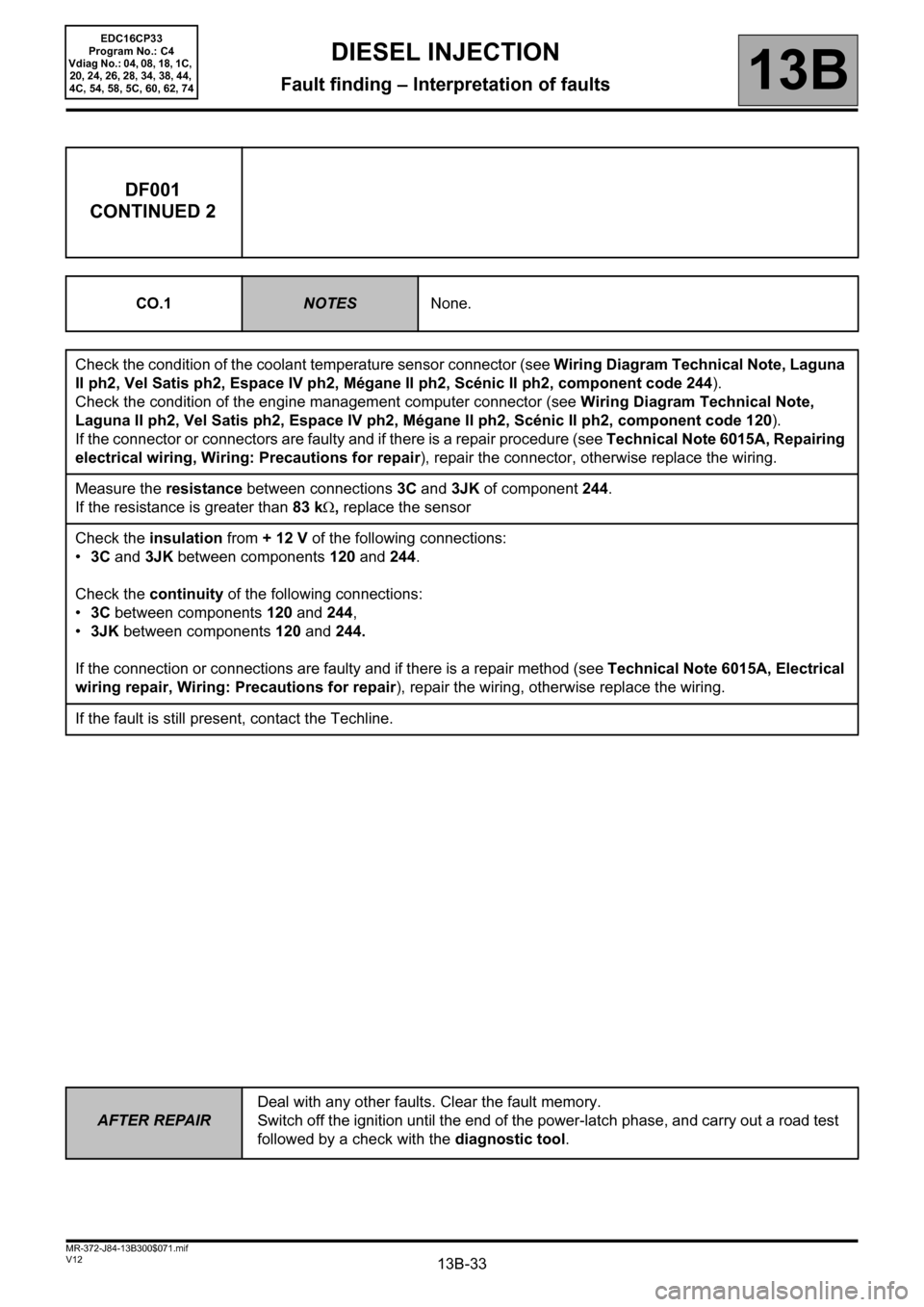
13B-33
AFTER REPAIRDeal with any other faults. Clear the fault memory.
Switch off the ignition until the end of the power-latch phase, and carry out a road test
followed by a check with the diagnostic tool.
V12 MR-372-J84-13B300$071.mif
DIESEL INJECTION
Fault finding – Interpretation of faults13B
EDC16CP33
Program No.: C4
Vdiag No.: 04, 08, 18, 1C,
20, 24, 26, 28, 34, 38, 44,
4C, 54, 58, 5C, 60, 62, 74
DF001
CONTINUED 2
CO.1NOTESNone.
Check the condition of the coolant temperature sensor connector (see Wiring Diagram Technical Note, Laguna
II ph2, Vel Satis ph2, Espace IV ph2, Mégane II ph2, Scénic II ph2, component code 244).
Check the condition of the engine management computer connector (see Wiring Diagram Technical Note,
Laguna II ph2, Vel Satis ph2, Espace IV ph2, Mégane II ph2, Scénic II ph2, component code 120).
If the connector or connectors are faulty and if there is a repair procedure (see Technical Note 6015A, Repairing
electrical wiring, Wiring: Precautions for repair), repair the connector, otherwise replace the wiring.
Measure the resistance between connections 3C and 3JK of component 244.
If the resistance is greater than 83 kΩ, replace the sensor
Check the insulation from + 12 V of the following connections:
•3C and 3JK between components 120 and 244.
Check the continuity of the following connections:
•3C between components 120 and 244,
•3JK between components 120 and 244.
If the connection or connections are faulty and if there is a repair method (see Technical Note 6015A, Electrical
wiring repair, Wiring: Precautions for repair), repair the wiring, otherwise replace the wiring.
If the fault is still present, contact the Techline.
Page 34 of 510
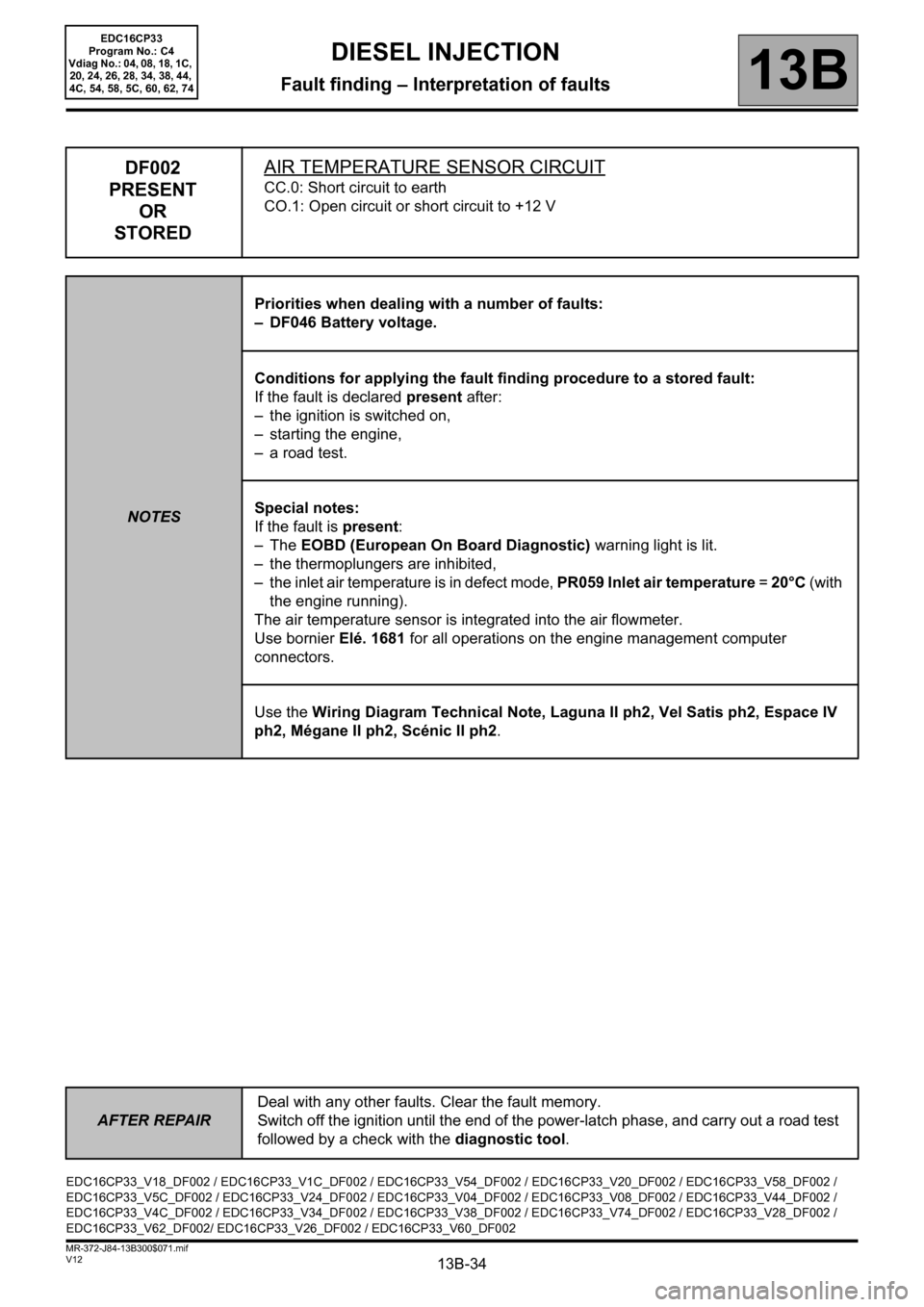
13B-34
AFTER REPAIRDeal with any other faults. Clear the fault memory.
Switch off the ignition until the end of the power-latch phase, and carry out a road test
followed by a check with the diagnostic tool.
V12 MR-372-J84-13B300$071.mif
DIESEL INJECTION
Fault finding – Interpretation of faults13B
EDC16CP33
Program No.: C4
Vdiag No.: 04, 08, 18, 1C,
20, 24, 26, 28, 34, 38, 44,
4C, 54, 58, 5C, 60, 62, 74
DF002
PRESENT
OR
STOREDAIR TEMPERATURE SENSOR CIRCUIT
CC.0: Short circuit to earth
CO.1: Open circuit or short circuit to +12 V
NOTESPriorities when dealing with a number of faults:
– DF046 Battery voltage.
Conditions for applying the fault finding procedure to a stored fault:
If the fault is declared present after:
– the ignition is switched on,
– starting the engine,
– a road test.
Special notes:
If the fault is present:
–The EOBD (European On Board Diagnostic) warning light is lit.
– the thermoplungers are inhibited,
– the inlet air temperature is in defect mode, PR059 Inlet air temperature = 20°C (with
the engine running).
The air temperature sensor is integrated into the air flowmeter.
Use bornier Elé. 1681 for all operations on the engine management computer
connectors.
Use the Wiring Diagram Technical Note, Laguna II ph2, Vel Satis ph2, Espace IV
ph2, Mégane II ph2, Scénic II ph2.
EDC16CP33_V18_DF002 / EDC16CP33_V1C_DF002 / EDC16CP33_V54_DF002 / EDC16CP33_V20_DF002 / EDC16CP33_V58_DF002 /
EDC16CP33_V5C_DF002 / EDC16CP33_V24_DF002 / EDC16CP33_V04_DF002 / EDC16CP33_V08_DF002 / EDC16CP33_V44_DF002 /
EDC16CP33_V4C_DF002 / EDC16CP33_V34_DF002 / EDC16CP33_V38_DF002 / EDC16CP33_V74_DF002 / EDC16CP33_V28_DF002 /
EDC16CP33_V62_DF002/ EDC16CP33_V26_DF002 / EDC16CP33_V60_DF002